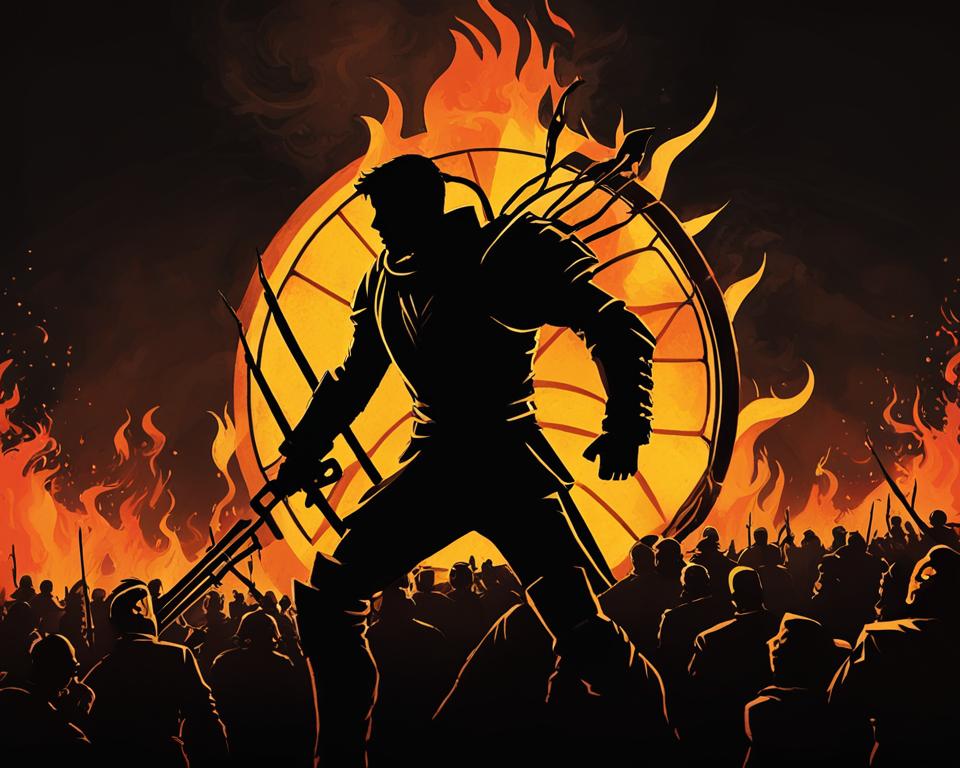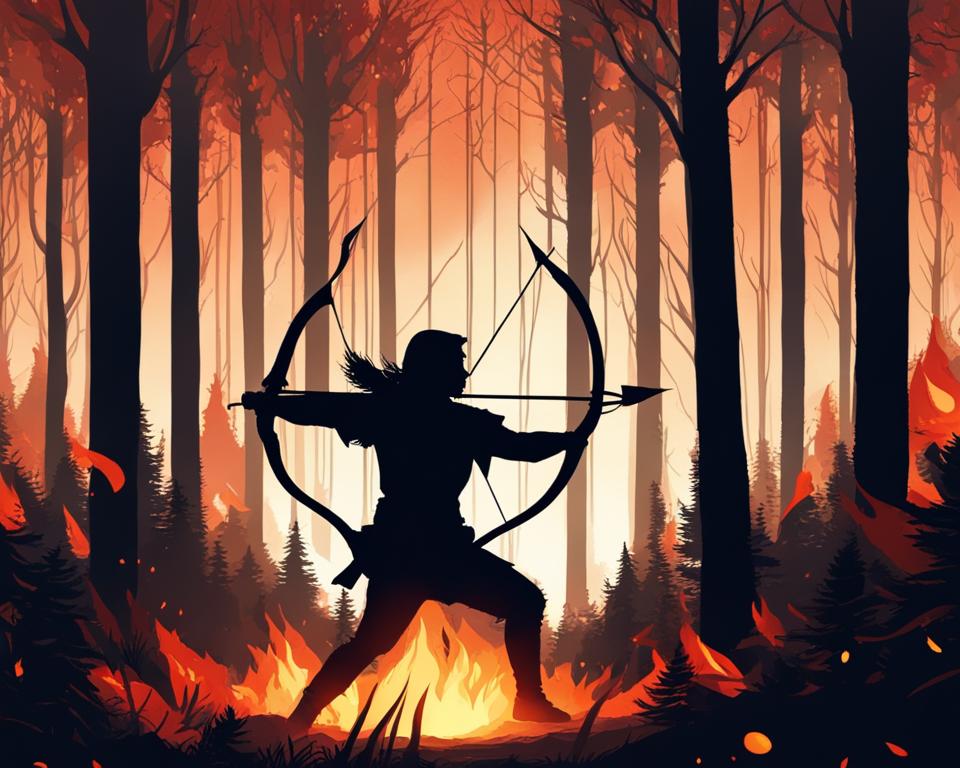Join us for an exciting audiobook review of “Catching Fire” by Suzanne Collins. This enthralling sequel is packed with suspense, adventure, and heart, keeping listeners at the edge of their seats from start to finish.
In this review, we’ll analyze the plot, characters, narration, and themes to give you a comprehensive overview of this beloved book. Whether you’re a fan of dystopian YA fiction or audiobooks, “Catching Fire” is a must-listen.
Key Takeaways:
- “Catching Fire” by Suzanne Collins is a thrilling sequel packed with adventure and heart.
- Listeners will be captivated by the plot, characters, and themes of this dystopian YA fiction.
- The audiobook narration brings the story to life, enhancing the overall experience.
- “Catching Fire” received critical acclaim and had a significant cultural impact, cementing its place in literary history.
- This must-listen audiobook is perfect for fans of the dystopian genre and audiobooks alike.
Introduction to “Catching Fire”
Welcome to the second book in the dystopian trilogy by the renowned author Suzanne Collins. The “Catching Fire” audiobook introduces us to the continuation of the story and the challenges faced by the characters.
Join us on an adventure to Panem, where the Hunger Games continue, and the rebellion is brewing. In this thrilling sequel, we explore the expansive world Collins has created and delve deeper into the lives of our beloved characters.
The “Catching Fire” audiobook is an enchanting addition to the trilogy, transforming the reading experience. Whether you’re new to the books or revisiting the series, this audiobook will transport you to a world full of danger, romance, and adventure.
Plot Summary
As the second installment in the riveting trilogy, “Catching Fire” by Suzanne Collins explores the journey of the resilient Katniss Everdeen as she becomes the leader of the rebellion in Panem. The plot highlights Everdeen’s life after winning the 74th Hunger Games, where her defiance sparked a revolution in the various districts of Panem.
As Everdeen prepares for the 75th Hunger Games, known as the Quarter Quell, she faces an increasing number of dangers and challenging obstacles. Alongside fellow tribute, Peeta Mellark, Everdeen navigates the treacherous landscape of the arena, hoping to outlast and outwit their opponents.
The plot reaches a thrilling climax, as Everdeen emerges as a symbol of hope for Panem. However, with the Capitol determined to stop the rebellion at any cost, Everdeen’s journey becomes more perilous than ever before.
“I wish I could gather everyone up and explain it to them. To the rebels in District Eight. To the spectators on the Capitol balconies. They would not be cheering if they understood the cost of their entertainment. But I am not Gale. I can’t even stir a rebellious thought in my own mind. What I’m really afraid of is that someday we will all stop laughing and start shouting. That, contrary to the old adage, misery may not love company. Misery may insist on keeping to itself.” – “Catching Fire”, Suzanne Collins
Character Analysis
The characters in “Catching Fire” are complex and multi-dimensional, each with their own motivations and challenges. Suzanne Collins has created a world in which the actions of the characters have far-reaching consequences for both themselves and the greater society of Panem.
Katniss Everdeen, the protagonist of the series, continues to struggle with the emotional trauma of her experiences in the Hunger Games. Her relationships with Peeta Mellark and Gale Hawthorne are fraught with tension as she tries to navigate her feelings and responsibilities. In “Catching Fire,” Katniss becomes a symbol of rebellion against the Capitol, a role which both empowers and endangers her.
“I don’t want to lose the boy with the bread.”
Peeta Mellark, the boy with the bread, is a compassionate and empathetic character who continues to support Katniss throughout the series. His love for her is evident, but his efforts to keep her safe often put him in danger. Peeta’s kindness and selflessness make him a beloved and tragic character, whose fate is uncertain until the very end.
The other characters in “Catching Fire,” such as Haymitch Abernathy and Effie Trinket, also play integral roles in the story. Through their interactions with Katniss and Peeta, they provide insight into the world of the Capitol and the motivations of those in power.
Overall
Suzanne Collins’ ability to create complex and nuanced characters is a hallmark of her writing. In “Catching Fire,” Katniss Everdeen and Peeta Mellark continue to evolve and develop, providing a compelling and emotional journey for readers.
Narration and Performance
Listening to the “Catching Fire” audiobook is an immersive experience where Suzanne Collins vividly brings her story to life. With outstanding narration from Emmy Award-winning actress Tatiana Maslany, the compelling narration transports listeners to the world of Panem. Her engaging performance brings an emotional depth to the characters, highlighting their struggles and intensifying the plot. Maslany’s distinct tone and intonation create an atmosphere of suspense and urgency, further captivating listeners.

Collins’ writing, combined with Maslany’s narration, delivers a remarkable listening experience. Her interpretations of the characters’ personalities and emotions are awe-inspiring, captivating, and leave listeners wanting more. Whether you’re experiencing “Catching Fire” for the first time or revisiting the story, the audiobook version is a fantastic way to enjoy the book.
Setting and World-building
Step into the world of Panem and explore the dystopian society portrayed by Suzanne Collins in “Catching Fire.” The vivid setting is a hallmark of the book and captures the imagination of readers. From the squalor of District 12 to the grandeur of the Capitol, every location is meticulously described, transporting readers to a whole new world.
The setting in “Catching Fire” plays a crucial role in advancing the story, shaping the characters, and conveying the overarching themes of the book. The intricate world-building of Collins masterfully paints a picture of a society ravaged by inequality and injustice. As readers delve deeper into the book, they are immersed in the intricacies of the political system and the machinations of the ruling elite, adding to the intrigue and tension.
The “Catching Fire” setting is undoubtedly one of the book’s highlights, transporting readers to a truly captivating world. The vivid descriptions and attention to detail in every scene help to elevate the story and make it feel more authentic. This aspect of the book is a testament to Suzanne Collins’ impressive world-building skills and ability to transport readers to a different time and place.
Writing Style and Themes
Suzanne Collins’ writing style in “Catching Fire” is just as gripping as the first book in the trilogy, “The Hunger Games.” Her skillful use of first-person narration immerses readers into the story and the world she has created. Collins’ prose is straightforward yet descriptive, allowing for detailed world-building without detracting from the fast-paced plot.
At its core, “Catching Fire” explores themes of oppression, rebellion, and the power of propaganda. Through the struggles and triumphs of protagonist Katniss Everdeen, Collins delivers a message about the capacity for change and the human spirit. The story also touches on more subtle themes such as the cost of fame and the complexities of relationships.
“I wish I could freeze this moment, right here, right now and live in it forever.” – Suzanne Collins, “Catching Fire”
The themes and messages woven throughout “Catching Fire” resonate with readers and have made it a beloved addition to the dystopian genre. Collins’ writing style and storytelling serve as a testament to her prowess as an author and the impact of her work.
Reception and Impact
Since its release in 2009, “Catching Fire” has received critical acclaim and left a lasting cultural impact. Many critics praised Suzanne Collins’ story and characters. The book was a New York Times bestseller for more than 100 weeks.
The novel’s engaging narrative and themes of survival, sacrifice, and social inequality resonated with readers of all ages. “Catching Fire” cemented the “Hunger Games” trilogy’s place in popular culture and established Suzanne Collins as a literary icon.
“Catching Fire is outstanding…as Katniss struggles to balance inner turmoil and outward strategy, the scope of Collins’s vision becomes apparent, all while leaving the reader breathless and on the edge of their seat throughout.” – Publishers Weekly
The success of “Catching Fire” sparked a flurry of adaptations, including a blockbuster film franchise and stage play. Suzanne Collins’ imagination and skill as a writer continue to inspire new generations of fans and aspiring authors.
Impact on Society
Like its predecessor, “Catching Fire” generated critical discussion and reflection on pressing social issues, such as government control and wealth inequality. The novel’s themes and characters have inspired activism and brought the dystopian genre to the forefront of popular culture.
- Catching Fire contributed to the rise of dystopian young adult fiction.
- The novel has influenced fashion, with fans replicating Katniss Everdeen’s iconic braids and outfits.
- The “Hunger Games” franchise has become a significant part of popular culture, with its impact extending to video games, costumes, and fan communities.
Overall, “Catching Fire” is a testament to the power of storytelling and its ability to inspire and impact society.
Comparison with the Previous Book
“Catching Fire” vs “The Hunger Games” – two books with similar themes but different tones. While the first book sets up the world and the premise, the second installment takes it up a notch with the character development and plot twists.
In “The Hunger Games,” we see Katniss Everdeen fight for her survival in the arena. As the story progresses, she becomes a symbol of rebellion against the Capitol. “Catching Fire” takes off from where the first book left off with Katniss facing the aftermath of her victory.
The sequel follows a darker and more complex narrative, with Collins exploring deeper themes of political resistance and the consequences of rebellion. The character development is also more nuanced, especially with the introduction of new characters like Finnick and Johanna.
The tension between Katniss and Peeta Mellark also becomes more pronounced, with their relationship growing more complicated as the story unfolds. Overall, “Catching Fire” is a well-crafted sequel that adds more layers to the complex world and characters created by Suzanne Collins.
Conclusion
Overall, “Catching Fire” is a captivating audiobook that will leave listeners on the edge of their seats. Suzanne Collins’ vivid world-building and complex characters make for an enthralling experience. The narration and performance elevate the story, immersing listeners in the dystopian society of Panem.
The themes explored in “Catching Fire” provide thought-provoking social commentary that resonates with readers. The critical reception and cultural impact of the book further illustrate its significance in the literary world.
When compared to “The Hunger Games,” “Catching Fire” showcases impressive character development and story progression. It seamlessly builds upon the foundation set by the first book while introducing new challenges and dangers for Katniss Everdeen.
In conclusion, we highly recommend the “Catching Fire” audiobook to fans of dystopian fiction and all those looking for a thrilling adventure. It will not disappoint.



